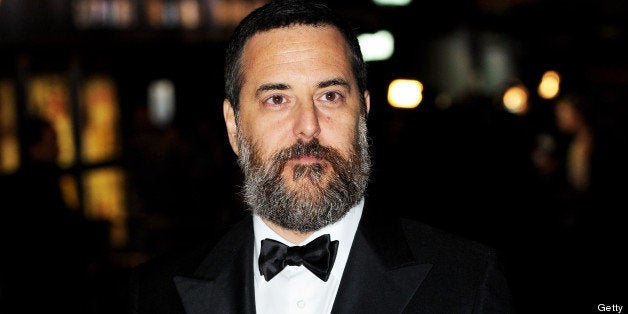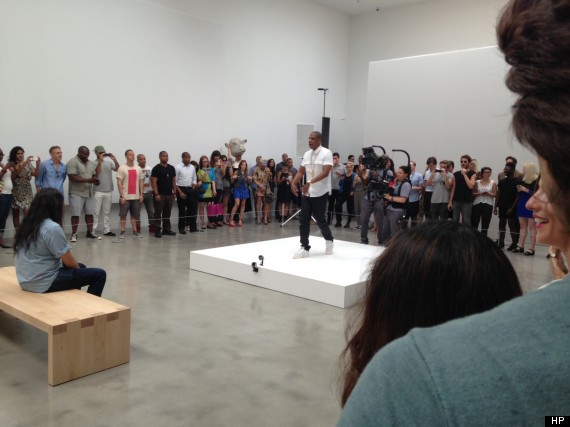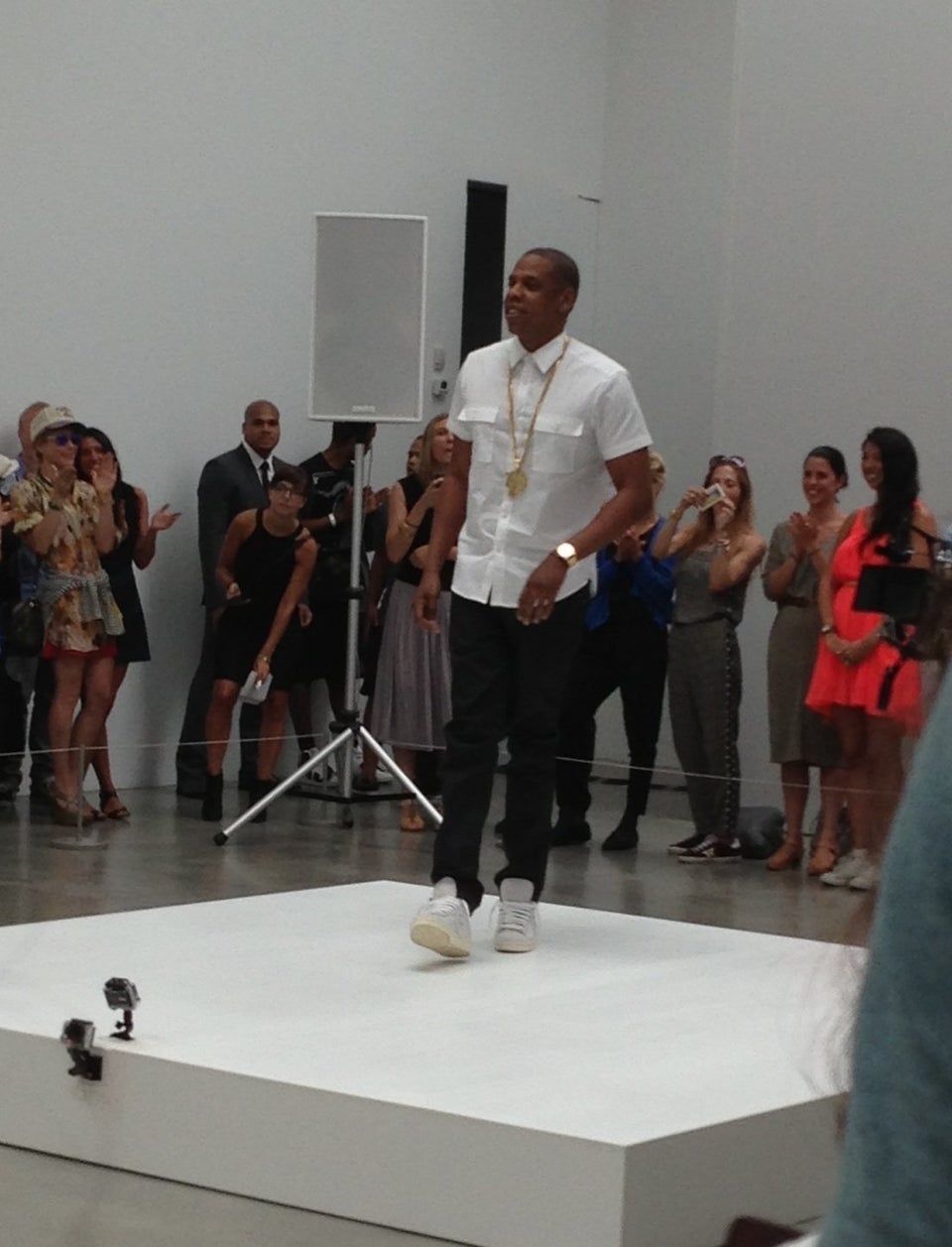
If the art world and the hip-hop world have one thing in common, it's a hearty appetite for controversy. (And before members of both camps start flaming me, yes, I realize they have more than just that in common.) So it was probably inevitable that Jay Z's decision to stage a "performance piece" at the Pace Gallery over the course of six hours would stir passions. To some in the art world, ever suspicious of celebrity incursions, it was a debasement of the form. To some in the hip-hop world, ever suspicious of crossover betrayals, it was a flagrant display of elitism.
But what was Jay Z himself trying to achieve? According to Mark Romanek, who conceptualized the event and directed the resulting half-hour documentary (set to air on HBO this Friday at 11 pm), the inspiration was simple. Romanek had seen the 2012 film "Marina Abramovic: The Artist Is Present," which documented the Serbian-born artist's marathon series of one-on-one interactions with visitors at the Museum of Modern Art in New York, and become fascinated by the intimacy she achieved. "What I pitched to Jay was: 'You regularly perform to 60 or 80,000 people at a time. What if you performed for one person at a time? What if it was like Marina's piece?"" Romanek says.
That helps explain why Romanek insists on calling the "Picasso Baby" session a piece of performance art, rather than a music video. And it helps explain why Jay Z rapped the lyrics live instead of lip syncing -- despite what you may have read in Gawker or The New Yorker. "They're both dead wrong," Romanek says. "At no point during the day did he lip sync. He did live vocals for six hours. The finished piece was always intended to be live vocals. I mean, that was the whole point of it. Otherwise, it would turn into a music video."
Romanek has directed some of the most memorable music videos of the past 20 years, including Johnny Cash's "Hurt," Fiona Apple's "Criminal" and Jay Z's "99 Problems," but he's mostly focused on features these days. His 2002 film "One Hour Photo," with Robin Williams in the lead, grossed $31 million domestically, and in 2010 he followed it up with "Never Let Me Go," starring Carey Mulligan and Andrew Garfield. So when Jay Z called and proposed a collaboration, Romanek had to ask himself if he wanted to do another music video. "And the answer was no," he says. "But do I want to work with Jay Z on this amazing album? The answer was absolutely, so how do we invent a new thing that we would both be excited by?"
I chanced into an invitation to the "Picasso Baby" shoot (event? happening? I don't know what to call it anymore), and thought it was pretty cool. Earlier this week, I asked Romanek how it all went down. Here are some highlights from our conversation.
How did the idea for all this come about?
About three months ago, Jay invited me to his office to hear the album. I was really impressed. I thought it was his most mature album and I thought it was a real leap for him, and we both expressed a dissatisfaction with the way things are done and a desire to do something different. He name-checks a lot of artists, so it immediately put me to mind of the whole fine-art world, and since he's a performer I started thinking about a performance-art piece involving Jay's music. And every time we tried to think of something that was radically different from Marina [Abramovic]'s piece, it never seemed as good. So we said, what if we do something very much like that? But it was important to me that we weren't just ripping her off, that we had her blessing, so we reached out to her and she loved the idea and said she'd be happy to bless the event with her presence. The phrase "music video" got tossed around a little bit at the beginning, and both of us were like, "We don't want to do a music video. That's from another era. We need to do something that's more genuine, more spontaneous and more alive."
So you do reject the term "music video" for this project?
Yeah. I mean, I don't think that's what it is. I think it's a document of an art happening in the old-school sense of an art happening. We had no idea how it was going to go. It could have flopped. It could have been a dud. It wasn't. It was really fun and exciting. Jeanne Greenberg Rohaytn helped us assemble a guest list of people from the art world that we hoped would have a lot of variety. We set it up as much as we could as if it were an art event -- the invitations and the posters and the text on the wall. And then we sort of flipped the "on" switch and filmed what happened. I was not really controlling anything. All I was trying to do was control it as a filmmaker by monitoring the cameras and making suggestions about how to cover it.
So you had Jay on a platform, one notable person watching him, then a whole group of people around the perimeter of the room. How did you come up with that basic setup?
The initial thing, what I pitched to Jay was, you regularly perform to 60 or 80,000 people at a time. What if you performed for one person at a time? What if it was like Marina's piece? And it evolved from there in terms of how to build it, and he got very excited by that. I mean, halfway through me pitching it to him, he said, "Wait, wait, I got chills. That's exactly what we should be doing." In terms of notable people, obviously we wanted it to have an art-world slant, but it's a somewhat democratic range of people. There were bands that were invited that are just Jay Z's fans, there were people that are just New York people, they're actors and musicians and other New York people. We wanted it to be a mix.

Whose idea was it to invite the larger group to crowd around toward the end of the song?
The song is unique in that it's sort of broken into two parts. The first half of it is one kind of track, and then it doesn't just slightly change, it completely changes. So Jay and I did discuss, well, what are we going to do visually to highlight that big shift in the song? And I suggested, what if you invite people to break that barrier and just invite them in? So we tried it, and it did create a new energy for that second part of the track.
One of the defining features was the social-media sharing inside that room. My feelings about it went from, I can't believe they're letting me take pictures, to, Oh, of course, this is exactly what they want. But was it what you wanted, or did that just kind of occur?
Well, from the very beginning, part of the basic pitch was, we'll let people do social media, we'll let people Tweet about it, we'll let people take pictures. That was definitely part of the DNA of the thing, and part of what we thought would feel very of-the-moment about it. What we wanted to do was control it a little bit so that maybe it was going to be people waiting outside, you know, peeking in. And then, a la Abramovic, we put up all these signs saying NO PHOTOGRAPHY INSIDE THE GALLERY. And that became a joke after about three seconds. There are 250 people in the room and 249 of them had a camera out, so we had a choice to make at that point. We could either become sort of fascist about it and say, "Oh, put your cameras away," or just go with it. And instantly everyone said let's just go with it. And I think it turned out great. When you see the finished piece, I think you'll see that it didn't really spoil anything, because frankly the finished piece is more polished and more beautiful.
When I was there, he was rapping, and yet Gawker and Sasha Frere-Jones of The New Yorker have reported that he was lip syncing. Did he lip synch at all during the performance?
They're both dead wrong. It was never meant to be lip synced. At no point during the day did he lip sync. He did live vocals for six hours. The finished piece was always intended to be live vocals. I mean, that was the whole point of it. Otherwise, it would turn into a music video. He had a lavalier microphone on his chest that captured a beautiful vocal. It's completely obvious when you see the piece that it's not lip synced. Because every inflection and emotion that he performed on that day is different than anything like what's on the album. He's laughing. And one woman in her 60s showed up who was so elegant that he literally became speechless. He said, "You're making me lose my flow, but I'm gonna get it back in a minute." So we kept that in the video. He stopped singing at times and just talked to people, he kissed people. What you'll see is that it's like a tsunami of joyfulness. It's sort of the opposite of the tough-guy street-rapper cliché. Everyone is having such a good time and none of it is feigned. There's not a single fake moment in it. It's just a document of people having a really good time, Jay included.
I thought the live performance was key to that. To stand there and watch Jay lip sync would be one thing, but to be in a gallery space with him and listen to him rap with no in-room amplification -- everybody in there had to realize they were witnessing something special.
That was the whole point. For him to lip sync would be completely foundationally short-circuiting the whole point. I think that those people, Jones and Gawker, seem to have an axe to grind about the whole thing. You know, people are critiquing it based on a teaser and some other press. It's come to the point where people make reviews of trailers rather than waiting for the actual piece.
While we're on the topic of that New Yorker piece, Sasha Frere-Jones also writes that, in the wake of the Trayvon Martin verdict, Jay's album feels irrelevant, especially compared with Kanye West's angrier "Yeezus." What's your take on where Jay-Z is as an artist right now and how that relates to the moment we're experiencing?
You know, it's not my job to have a take on it publicly. I think it's his best album. I think it's extremely mature. It's not an album filled with catchy pop hits. It's a much more mature expression of where he's at right now. I listen to it constantly. I listen to the Kanye record, too. I think they're both very good records. They're obviously both very different. But my opinion is that it's Jay's best album. If Mr. Jones disagrees, that's his decision.
You and Jay collaborated on the "99 Problems" video nine years ago. How different was the collaboration this time around?
Well, it was the same in the sense that it was an excellent professional experience. He's not a micromanager. He likes to work with talented people and he'll be very firm about certain foundational aspects to it, but then after that he'll be very trusting and allow you to do what he's asked you to do on his behalf as a collaboration. But we're both nine years more mature. We're both parents now and we weren't before, and we both have different interests. And in a lot of ways I think, as different as our upbringings were, we seem to have affinities for the same ideas.
You've directed some of the coolest music videos ever. Do you really think the era of music videos is over?
Well, I haven't been thinking about music videos, I've been thinking about features. So when he said, "Would you like to do something?," that's when I said, "Oh, do I want to do a music video?" And the answer was no. But do I want to work with Jay Z on this amazing album? The answer was absolutely, so how do we invent a new thing that we would both be excited by? I guess in this day and age it just seems that, to come up with a concept and then artificially execute it and then have it be this finished, hermetically sealed thing is really irrelevant to what's going on in the world.
What's your favorite music video ever?
That's a tough one. I mean, the one that pops into my mind is one Spike Jonze made for the band Wax. The song is called "California," and it's that man running down the street in slow motion on fire. And it's all a single take. To me that's truly a piece of short film art that works perfectly as a music video. It's perfect and brilliant and human.
"Picasso Baby: A Performance Art Film" debuts on HBO on August 2 at 11 pm ET.
